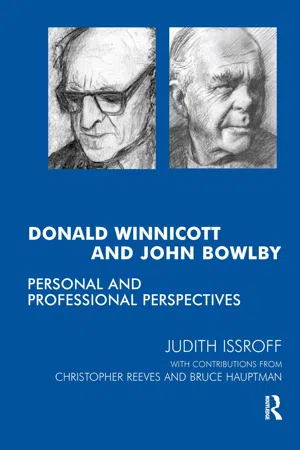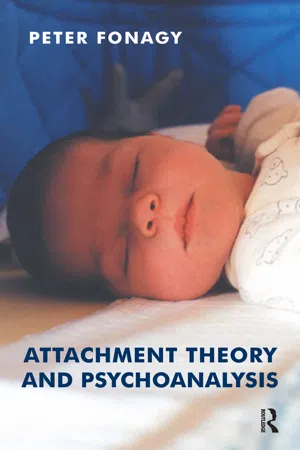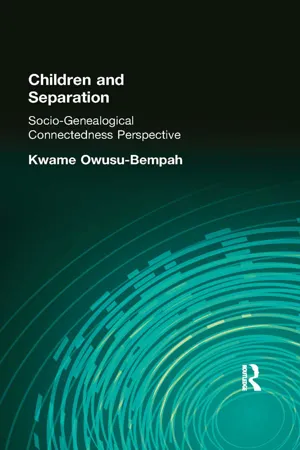Psychology
Forty Four Juvenile Thieves
"Forty Four Juvenile Thieves" refers to a study conducted by psychiatrist John Bowlby, which aimed to investigate the impact of early maternal deprivation on children's behavior. The study found that children who experienced early separation from their mothers were more likely to exhibit delinquent behavior. This research contributed to the understanding of attachment theory and the importance of early caregiver-child relationships in psychological development.
Written by Perlego with AI-assistance
Related key terms
Related key terms
1 of 4
Related key terms
1 of 3
3 Key excerpts on "Forty Four Juvenile Thieves"
- eBook - ePub
Donald Winnicott and John Bowlby
Personal and Professional Perspectives
- Bruce Hauptmann, Christopher Reeves, Judith Issroff(Authors)
- 2018(Publication Date)
- Routledge(Publisher)
He was referring, of course, to John Bowlby, who in 1944 had provided Ernest Jones, then Editor of the International Journal of Psycho-Analysis and currently short of copy, with a long research paper, indicating as he did so that the paper had previously been rejected by the British Journal of Medical Psychology as being deficient in the discussion of theory. But Ernest Jones apparently entertained no such qualms about its suitability for the Journal, and Bowlby’s famous paper, “Forty-Four Juvenile Thieves: Their Characters and Home Life” (1944), duly appeared. So well received was it that two years later it was printed as a separate monograph destined for a wider lay public. From then on, Bowlby became a household name. Among his fellow analysts he was dubbed “Ali Bowlby and his 40 Thieves” (Holmes, 1993, p. 21). Even Winnicott, with his habit of not acknowledging his indebtedness to others’ work while engaged in giving personal shape to his ideas and insights (Winnicott, 1945c/1958, p. 145), could not afford to ignore the impact on him of Bowlby’s contribution. The message of Bowlby’s 1944 paper had been simple: namely, that there was a demonstrable correlation between separation from or rejection by the mother in early childhood and that child’s later antisocial behaviour. Extreme cases of prolonged separation or outright rejection could lead to the later formation of “the affectionless character”, exemplified in the young persistent thief who strikingly lacked the capacity to show or receive affection and appeared utterly devoid of shame, guilt, or a sense of responsibility for his—or her— delinquent behaviour - eBook - ePub
- Peter Fonagy(Author)
- 2018(Publication Date)
- Routledge(Publisher)
John Bowlby’s work on attachment theory started when, at the age of 21, he worked in a home for maladjusted boys. Bowlby’s clinical experience with two boys, whose relationships with their mothers were massively disrupted, made a profound impact on him. A retrospective study he carried out ten years later, examining the history of 44 juvenile thieves (Bowlby 1944), formalized his view that the disruption of the early mother–child relationship should be seen as a key precursor of mental disorder. The one factor that distinguished the thieves from the clinic children was evidence of prolonged separation from parents, particularly striking among those whom he termed “affectionless.” In the late ’40s Bowlby extended his interest in mother–infant relations by undertaking a review of research findings on the effects of institutionalization on young children (Bowlby 1951). Children who had been seriously deprived of maternal care tended to develop the same symptoms as he had identified in his “affectionless” young thieves. While giving central place to parenting in general and the infant–mother relationship in particular, the 1951 monograph was silent on the mechanisms by which maternal deprivation might be expected to generate adverse consequences. The maternal deprivation literature was itself wide open to alternative interpretations, particularly ones that deemphasized the mother-infant bond (e.g., Rutter 1971). At about the same time, James Robertson, with Bowlby’s encouragement, spent 4 years documenting on film the impact on 18- to 48-month-olds of separation from the parents during an episode of hospital admission or admission to residential nurseries (Robertson 1962). Later, more systematically collected behavioral observations and descriptions that fully confirmed the Robertson material were collected by Christopher Heinicke (Heinicke and Westheimer 1966).Bowlby was dissatisfied with prevailing views in the first half of the twentieth century concerning the origin of affectional bonds. Both psychoanalytic and Hullian learning theory stressed that the emotional bond to the primary caregiver was a secondary drive, based on the gratification of oral needs. Yet evidence was already available that, in the animal kingdom at least, the young of the species could become attached to adults who did not feed them (Lorenz 1935). Bowlby (1958) was among the first to recognize that the human infant enters the world predisposed to participate in social interaction. Developmental psychology has made this discovery something of a truism (e.g., Meltzoff 1995, Watson 1994). Around the midpoint of the last century, however, Bowlby’s determination to give central place to the infant’s biological proclivity to form attachments to initiate, maintain, and terminate interaction with the caregiver and use this person as a “secure base” for exploration and self enhancement, flew in the face of another kind of (pseudo)biological determinism—one based on the theory of libidinal and aggressive instincts. - eBook - ePub
Children and Separation
Socio-Genealogical Connectedness Perspective
- Kwame Owusu-Bempah(Author)
- 2014(Publication Date)
- Routledge(Publisher)
It is an unquestionable fact that until his death in 1990, at age of 83, John Bowlby was (and continues to be) a highly influential theorist and writer on child development. His legacy still endures. Holmes (1993) has described attachment theory as one of the most important theoretical developments in psychoanalysis since Freud; that the theory has had an enormous impact on child development, social work, psychotherapy, psychology and psychiatry. To this list we must add education and family law, at least in relation to child custody and adoption decisions. Among Bowlby’s most important studies was ‘The Forty-Four Juvenile Thieves’. This seminal work firmly linked emotional and behavioural problems in childhood with ‘broken homes’ – maternal (parental) separation – and formed the impetus for attachment theory’s development. The study held delinquency and inability to form meaningful relationships to be the consequences of ‘broken homes’. Bowlby’s later report (1951) to the World Health Organization (WHO) popularized and reinforced this belief:The evidence is now such that it leaves no room for doubt … that the prolonged deprivation of a young child of maternal care may have grave and far reaching effects on his character and so on the whole of his future life.(quoted in Howe, 1995, p. 47)Together with Bowlby’s other claims this became a creed which, bolstered by similar conclusions reached by subsequent studies, has influenced not only research but also family law and professional childcare practice globally.‘THE FORTY-FOUR JUVENILE THIEVES’
In this study Bowlby (1944) compared the behavioural and emotional development of juvenile delinquents (aged between 5.7 years and 16.2 years) with those of a control non-delinquent client group, matched in terms of age and socio-economic status. On the basis of his clinical diagnoses, he classified the children into six character types (see Table 3.1 ).The ‘affectionless characters’ (or ‘antisocial psychopaths’) were identified as the most incorrigible and troublesome subgroup among the thieves. Their distinguishing features included ‘a remarkable lack of affection or warmth or feeling for anyone, solitariness, undemonstrativeness, and unresponsiveness’ (Bowlby, 1944, p. 38). They responded neither to kindness nor punishment. Such children truanted and ‘wandered’, which Bowlby saw as a characteristic sign of indifference to home ties: ‘The affectionless character is capable of neither attachment, affection, nor loyalty.’ He described them as unique and hard-nosed criminals, compared to the other groups of delinquents, and summarized their character unequivocally thus:
Index pages curate the most relevant extracts from our library of academic textbooks. They’ve been created using an in-house natural language model (NLM), each adding context and meaning to key research topics.
Explore more topic indexes
Explore more topic indexes
1 of 6
Explore more topic indexes
1 of 4


